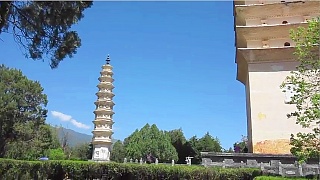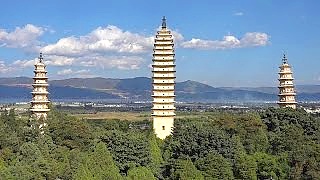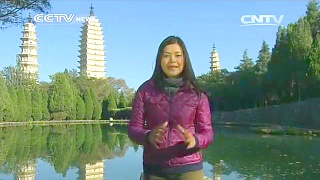With Feeding Foca ...
[video v=lO3R3gqkZOk]"The mountains are high,
and the emperor is far away."
Live more ...
With Feeding Foca ...
[video v=lO3R3gqkZOk]"The mountains are high,
and the emperor is far away."
With Soph ...
[video v=Za0tK-AuVMA]With Sun Kissed Bucket List ...
[video v=fSQteeMziYw]XiZhou Ancient Town is a gem of Yunnan Province, located approximately 20 kilometers from Dali’s old town. Nestled along the shores of the serene Erhai Lake, XiZhou offers a unique blend of rich Bai culture, stunning ancient architecture, and a tranquil environment, making it a must-visit for travelers seeking a more intimate and traditional experience.
XiZhou Ancient Town is an ideal destination for those wanting to immerse themselves in authentic Bai culture, ancient architecture, and the peaceful lakeside environment of Yunnan. Whether you're exploring ancient homes, tasting local delicacies, or enjoying the beauty of Erhai Lake, XiZhou provides a rich cultural experience in a relaxed setting.
With Walk China ...
[video v=zlzwjuPO48Y]ShuangLang ancient town is a charming and picturesque village located on the eastern shore of ErHai Lake, DaLi, Yunnan province. Known for its tranquil lakeside scenery, traditional Bai architecture, and vibrant arts scene, Shuanglang is an ideal destination for those looking to experience the natural beauty and cultural richness of the region.
The best time to visit Shuanglang is during the spring (March to May) and autumn (September to November) when the weather is mild and pleasant. Summers can be hot and rainy, while winters are cooler but still enjoyable for sightseeing.
Shuanglang offers a range of accommodation options, from luxury boutique hotels to budget-friendly guesthouses. Some recommended places to stay include:
Shuanglang Ancient Town offers a serene and culturally enriching travel experience. Whether you're exploring the scenic shores of Erhai Lake, delving into the rich Bai culture, or simply relaxing in a lakeside café, Shuanglang promises a memorable and peaceful retreat.
With JHMedium ...
[video v=OnsSk2CDNqs]Bonus film - cycling by the lake : with Yin's Eye ...
Plus more videos ...
With DuckTravel ...
[video v=_BMyVtQWiyI]With DuckTravel ...
[video v=u_bybHXAwUM]With Andy see the World ...
[video v=E_KeuW951mo]Traveling from Dali to Lhasa is an epic journey through some of China's most stunning landscapes. Here are two detailed scenic routes with notable stops along the way:
With Walk China ...
[video v=10i8uldtlHg]Exploring beautiful YunNan 云南 province
Including DaLi 大力, LiJiang 丽江, Tiger Leaping Gorge 虎跳峡 and ChengDu 成都. A great film - don't miss it ...
The beautiful Old Towns of LiJiang and DaLi, YunNan province
Scenic films. With CHN Tourism ... With Lucas & Ann ...
With Willene Business & Lifestyle ... Bonus film - with Seiu Travel ...
DaLi walking tour, YunNan province
With Walk East ...
Wonderful DaLi, YunNan province
With Walk East ...
14 years ago this american sold his house and moved to DaLi, China
美國大叔賣掉房屋,移居中國14年:在百年老宅找到人生理想
YunNan 云南 province, south west China
With Jordan Porter.
Street food tour in DaLi 大理, YunNan province
First, a beautiful time-lapse film by KevinWK. Don't miss it ... Plus, A trip to LiJiang (and Shangrila), YunNan ...
Exploring YunNan 云南 province ...
Beautiful and varied YunNan province, south central China, borders GuangXi, GuiZhou, SiChuan and Tibet, and the countries Vietnam, Laos and Myanma. With State of Zan ...
The Three Pagodas of ChongSheng Temple 崇圣寺三塔, DaLi, YunNan
LiJiang 丽江 and DaLi 大理. YunNan province
The 'old towns'. We begin with an Ultra HD (4K) video of Dali Old Town and the nearby Three Pagodas ...
Dali 大理, YunNan province - Travelogue
A fascinating, hour plus documentary by CCTV's Travelogue (from the English language CCTV9 channel). Dali is a four and a half hours drive from KunMing, the provincial capital of YunNan in south China, or forty minutes by air. By rail it is also connected to nearby LiJiang. We haven't posted a Travelogue for a couple of years, but are very happy to say that it is back to its best - intelligent presenter and beautiful cinematography. Highly recommended. Inhabited predominantly by the Bai and Yi ethnic groups. 1 : Dali Old Town 1/1 In this segment, presenter Katrina Yu tours the artistic cobblestone streets of the Old Town, meeting adventurous travelers along the way -- and shows where you can party with musical locals at night. 1/2 Katrina sails across the serenely beautiful ErHai Lake, enjoying a taste of ethnic Bai culture along the way. She also gets a lesson in an ancient handcraft and peeks inside a luxurious lakeside guesthouse. 1/3 Katrina strolls through the surrounding grounds of Dali's iconic Three Pagodas, and shows audiences the breath-taking view from the top of the soaring CangShan Mountains. 2 : The outskirts of Dali 2/1 Katrina hikes the holy paths of JiZu Mountain, one of the most sacred Buddhist sites in China, and discovers the historic temples which have given the area the nickname of "scented wonderland" 2/2 Katrina visits the traditional ethnic Bai village of XinHua. Join her as she is treated to a colorful 'Eight bowl' Bai banquet and gets a lesson in an age-old handicraft from a master silver maker. 2/3 Katrina wanders through the ancient town of ShaXi. Join her as she savors the sights and tastes of the bustling weekly market, and finds out how this age-old center has succeeded in becoming a modern tourist destination while maintaining its old-world charm. 3 : The 'thousand year old' village of NuoDeng, deep in rural Dali 3/1 Katrina and the crew arrive at the hillside village. They get a taste of Nuodeng's famous salted ham and meet a local man whose character is just as interesting as the temple he guards. 3/2 Katrina visits a unique family museum, and has her pulse checked at a guesthouse where the owners offer holistic health treatments as well as accommodation. 3/3 Katrina plays teacher and student for a day, getting a lesson in local culture at Nuodeng's lively primary school.
Beautiful DaLi 大理, YunNan province
Picturesque DaLi is located in YunNan province, south China, about 300 kilometers (185 miles) northwest of the provincial capital, KunMing. DaLi is surrounded by the CangShan mountains to the east, west and south, with ErHai Lake to the north. In this part of YunNan one can find 25 ethnic minorities (primarily the Bai people), which has created a unique cultural heritage bringing a charm to everyday life and a wide range of festivities. Famous attractions include the Butterfly Spring and the Three Pagodas of ChongSheng Temple. DaLi is also known for its highly prized marble, known as DaLi Stone. The old town is quite separate from the new city (called XiaGuan) and many buildings here, including the city walls and moat, date from the Ming dynasty (1368-1644). DaLi is a 20 minute flight from KunMing (75 minutes from ChengDu and ChongQing). There are also flights to ShangHai, BeiJing, ShenZhen, GuangZhou and GuiYuan. By rail, DaLi is connected to KunMing and LiJiang. 风景如画的大理位于云南省南部中国,约300公里的省会,昆明西北(185哩)。 大理是由苍山群山环绕,东,西,南,与洱海北部。在这部分云南人能找到25个少数民族(主要是白族人),这创造了一个独特的文化底蕴带来的魅力,日常生活和各种庆祝活动。 著名景点包括蝴蝶泉和崇圣寺三塔。大理也以其如获至宝大理石,被称为大理石。 老城区,距离新城区(称为下关)和许多建筑在这里,包括城墙和护城河,日期从明朝(1368-1644)完全分离。 大理距离昆明有20分钟的飞行(从成都和重庆75分钟)。也有航班到上海,北京,深圳,广州和桂圆。通过铁路,大理连接昆明和丽江。
The first film features KunMing and ShiLin (YunNan province), GuiLin and YangShuo (GuangXi province); the second LiJiang, Shangri-la and DaLi (YunNan province); and the third ZhouZhuang and SuZhou (JiangSu province) ...
Postcards from YunNan 云南 province
Beautiful scenes from south central China ...
The Three Pagodas of Dali are independent pagodas in Yunnan province. Arranged on the corners of a equilateral triangle, the Three Pagodas are located about 1.5 km (0.9 miles) north of the picturesque ancient town of Dali and face the west shore of ErHai Lake. The pagodas are made of brick and covered with white lime. The style is rather unique among China’s ancient Buddhist architecture and are a national treasure. The main pagoda, known as QianXun Pagoda, was constructed between 823 and 840 AD. It is 70 meters (227 feet) tall, square shaped and composed of sixteen stories with a carved white marble sitting Buddha statue at the center of each façade. The body of the pagoda is hollow from the first to the eighth story, surrounded by 3.3 meters (10 feet) thick walls. In 1978, more than 700 Buddhist antiquities, including sculptures of gold and silver, plus manuscripts, were found within during major reparations. The designers of the pagoda are said to have come from Xi’An, the capital of the Tang Dynasty at that time and also the location of another pagoda, the Small Wild Goose Pagoda, which shares a similar style but is about one hundred years older. The other two sibling pagodas, built some one hundred years later, are 42.2 meters (140 feet) high. Unlike the QianXun Pagoda, these are solid and octagonal, with ten stories. Behind the pagodas is a small lake called JuYing Chi (Reflection Pond), which provides a beautiful view of the Three Pagodas. In 1925 a major earthquake flattened almost every structure in Dali, but the Three Pagodas were undamaged and have stood now for well over a thousand years. The video is filmed by filmli08. We have simply tried to improve the video quality of the low-resolution original.
In October 2008. Places visited include Green Lake Park in KunMing, the Stone Forest at ShiLin, and DaLi old town.
A trip around China 中国 - video
Filmed in summer 2009. Places include: 1: BeiJing and the Great Wall 2: PingYao, Xi'An 3: XiaHe, ChengDu, LiJiang, ZhongDian, DaLi 4: ShiLin, YangShuo 5: YangShuo, Hong Kong
Ancient DaLi, YunNan province - video
Dali is situated at the southern end of the legendary Silk Road and is home to the Bai ethnic minority.
A trip to DaLi 大理 and LiJiang 丽江, YunNan province
Filmed in November 2009